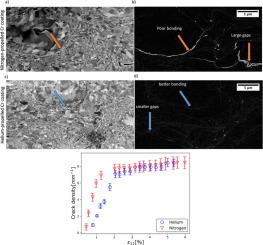Microstructure and mechanical performance of cold spray Cr coatings
IF 2.8
2区 工程技术
Q3 MATERIALS SCIENCE, MULTIDISCIPLINARY
引用次数: 0
Abstract
Cold spray deposition has emerged as a promising method for applying protective coatings in the nuclear industry, particularly for enhancing the accident tolerance of fuel assemblies. In this process, helium gas is often used to propel solid powder particles towards the target substrate, however, nitrogen gas is also considered due to its significantly lower cost. In this study, we investigate the influence of nitrogen and helium gas as propellants on the properties and microstructure of pure chromium (Cr) coatings on zirconium (Zr) alloy cladding tubes. Employing Scanning Electron Microscopy (SEM) and electron and x-ray diffraction techniques (EBSD, XRD), we explore the structural characteristics of the coatings. Additionally, in-situ SEM tensile testing at room temperature, coupled with Digital Image Correlation (DIC), is utilized to assess the coating cracking behaviour. Our findings reveal distinct differences in coating morphology and residual stress between nitrogen and helium propelled Cr coatings. The nitrogen-propelled coating exhibits a more porous structure with smoother coating/substrate interfaces and lower compressive residual stress compared to the helium-propelled one. This results in earlier strain-induced crack initiation and higher crack density at lower strains (0.5–2%). However, at higher strains (2–5%), both coatings demonstrate identical crack saturation densities (saturated number of cracks per unit length), accompanied by similar crack toughening mechanisms and evidence of shear strain bands at intercrack regions, indicative of plasticity onset.

冷喷铬涂层的微观结构和机械性能
冷喷沉积已成为核工业应用保护涂层的一种很有前途的方法,特别是用于提高燃料组件的事故耐受性。在这一过程中,通常使用氦气将固体粉末颗粒推向目标基底,但由于氮气的成本明显较低,因此也考虑使用氮气。在本研究中,我们研究了氮气和氦气作为推进剂对锆(Zr)合金覆层管上纯铬(Cr)涂层的性能和微观结构的影响。我们采用扫描电子显微镜(SEM)以及电子和 X 射线衍射技术(EBSD、XRD)来探索涂层的结构特征。此外,我们还利用室温下的原位扫描电子显微镜拉伸测试和数字图像相关性(DIC)来评估涂层的开裂行为。我们的研究结果表明,氮气和氦气推进的铬涂层在涂层形态和残余应力方面存在明显差异。与氦气推进的涂层相比,氮气推进的涂层表现出更多孔的结构,涂层/基体界面更光滑,压缩残余应力更低。因此,在较低应变(0.5%-2%)时,应变诱发的裂纹萌发较早,裂纹密度较高。然而,在较高应变(2%-5%)下,两种涂层显示出相同的裂纹饱和密度(单位长度上的饱和裂纹数),并伴有类似的裂纹增韧机制和裂纹间区域的剪切应变带,表明塑性开始出现。
本文章由计算机程序翻译,如有差异,请以英文原文为准。
求助全文
约1分钟内获得全文
求助全文
来源期刊

Journal of Nuclear Materials
工程技术-材料科学:综合
CiteScore
5.70
自引率
25.80%
发文量
601
审稿时长
63 days
期刊介绍:
The Journal of Nuclear Materials publishes high quality papers in materials research for nuclear applications, primarily fission reactors, fusion reactors, and similar environments including radiation areas of charged particle accelerators. Both original research and critical review papers covering experimental, theoretical, and computational aspects of either fundamental or applied nature are welcome.
The breadth of the field is such that a wide range of processes and properties in the field of materials science and engineering is of interest to the readership, spanning atom-scale processes, microstructures, thermodynamics, mechanical properties, physical properties, and corrosion, for example.
Topics covered by JNM
Fission reactor materials, including fuels, cladding, core structures, pressure vessels, coolant interactions with materials, moderator and control components, fission product behavior.
Materials aspects of the entire fuel cycle.
Materials aspects of the actinides and their compounds.
Performance of nuclear waste materials; materials aspects of the immobilization of wastes.
Fusion reactor materials, including first walls, blankets, insulators and magnets.
Neutron and charged particle radiation effects in materials, including defects, transmutations, microstructures, phase changes and macroscopic properties.
Interaction of plasmas, ion beams, electron beams and electromagnetic radiation with materials relevant to nuclear systems.
 求助内容:
求助内容: 应助结果提醒方式:
应助结果提醒方式:


